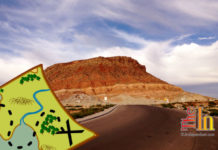
Water Conservancy District should get a lump of coal this Christmas, not more of our taxes
On Dec, 5 at 6 p.m. the Washington County Water Conservancy District will hold a public hearing to discuss its proposed tax increase. The word “tax” is nearly a curse word in Utah, and particularly in southern Utah. So what’s their rationale for this tax increase, and is it valid?
The following is an excerpt from the July 2018 Washington County Water Board meeting detailing water manager Ron Thompson’s concerns about property taxes for the district:
“Ron discussed the need of the district to bring the property tax levy to 0.001. It has dropped down to 0.00006, and the goal is to get it up to 0.001 by 2030. In the 6 p.m. public meeting, he will present a statement of the district’s intention to levy a tax rate that exceeds the district’s certified tax rate. The cost would be to an average home of $300,000 about $10 a year. There was some discussion among the board of raising it in smaller amounts over a number of years rather than raising it a lot at one time.”
Unlike many, if not most, other public meeting entities, the Water Conservancy District does not post the audio from its meetings, so I do not have more details about the July discussion. But it seems clear that the district wants more of our tax dollars.
I don’t know how accurate the $10 a year for an average home is. This may not seem like much, but taxes are taxes. They have a way of growing over time.
Subsidizing our water through taxes creates disconnect between how we use water and how much we use while doing nothing to encourage conservation. This regressive tax puts additional burden on those who can least afford to have their taxes increased, and those who pay rent will have the property owners’ taxes passed along to them. With unaffordable housing already a problem in Washington County, this tax increase should be rejected for this and other reasons I will describe.
A little history about Utah’s property tax laws sheds light on how we’ve arrived at our current situation. The current “Truth in Taxation” process came about due to increasing citizen concerns about the way local governments had been levying property taxes during a period from 1970 until the mid-1980s during which assessed property values had increased rapidly, averaging 13 percent per year. This situation provided a windfall to some local governments with tax revenues increasing faster than actual cost of services.
The 1985 Tax Increase Disclosure Act created a revenue-based tax system to replace the rate-based system and mandated a process to involve citizens if entities want to raise property taxes.
Utah Foundation’s “The Essential Tax — Property Tax 2018” explains the current situation this way:
“In theory, Truth in Taxation dictates that the property tax should generate the same revenue every year. However, there are two ways revenues can change. The first is that any new growth (like a new subdivision) would be taxed at the current rate, theoretically allowing growth in revenue commensurate with the new services required by the new subdivision.
The second way to increase revenue would be to increase the tax rate (or even just leave it the same) by going through the Truth in Taxation process.”
The Historical Overview of Utah’s Property Taxes states as follows:
“Utah’s ‘Truth in Taxation’ laws are revenue-driven, not rate-driven. That means the requirement to hold a ‘Truth in Taxation’ hearing is based upon the collections of a taxing entity, not the rate charged. Utah law requires ‘Truth in Taxation’ hearings to be held when a taxing entity elects to collect more revenue than was collected the previous year, although the entities are permitted to keep revenues generated by ‘new growth’ — such as value added to the tax rolls from a new subdivision or a new business.”
From 2006 to 2016, property taxes collected statewide have risen from $2.1 billion to $3.3 billion. Over that time period, an additional $1,200,537,384 has been raised in property taxes statewide with 55 percent of that going to schools and the remainder split between counties, cities and towns, and special districts such as the water district.
The Utah Foundation report reveals that “Revenues for school districts and special and local districts statewide have increased faster than inflation and population growth combined.” Our water district, as already noted, is considered a “special” district.
According to the 2017 audited financial report for the Washington County Water Conservancy District, 2017 property tax revenue increased by $489,000, a 4.6 percent increase. The current U.S. inflation rate is 2.5 percent as of October 2018. So the district seems to have been faring well. Also from the district’s 2017 audited financial report, the district enjoyed a decrease in general government expenses of 10.9 percent and a decrease in business expenses of 9.85 percent. I applaud the district for these achievements, but that does not mean it deserves more of our money. In fact, the same 2017 financial report reveals under Statement of Net Position (Dec. 31, 2017) that the district has $97,568,989 in “Cash & Cash Equivalents” and $73,822,571 in “Restricted Cash” totaling $171,391,560.
Additionally, from 2016 to 2017, impact fees collected by the district increased from $16.4 million to $26 million, so they are reaping the rewards of our latest growth spurt.
A Nov. 2 news report by KSL News provided information on how water districts statewide are doing when it comes to salaries:
“A little-known network of government agencies pay some of the highest salaries in the state. In fact, an analysis of compensation records for water districts show one-third of employees earn six-figure pay packages.
The water conservancy districts manage water resources across the state. Trustees and staff are largely un-elected.
Records provided by water conservancy districts to the Utah Transparency website show the top five employees earned on average over a quarter million dollars last year. Their compensation packages include benefits like healthcare and sometimes a car.
The KSL salary analysis also found 60 percent of water district employees make more than $68,000 a year, which was the state’s median income in 2017, according to the Census Bureau.”
To put this in perspective, the 2017 median annual wage for Washington County was $30,550 per the Utah Department of Work Services.
While our governor earns, according to the KSL story, $190,188 and our AG earns $187,433, our Washington County Water Conservancy District manager, Ron Thompson, who is asking for more of our tax dollars, earns $239,399. The Washington County Water Board, made up of seven members including three mayors and one county commissioner, sets these salaries.
I believe that our water district has done a good job providing water for our county’s residents. I don’t begrudge them decent salaries and benefits. But I do think things should be kept in perspective. If the district is so able to provide lucrative salaries and benefits that exceed those of some of our state’s highest officials, asking for more from tax payers is inappropriate.
Given all this, one must ask if a property tax increase is really necessary or is just to stash money away for the proposed but unnecessary Lake Powell Pipeline? That’s certainly how it appears, but our district and others throughout the state argue the property tax revenue stream is essential to their operation, often using their obligation to endangered species protection in rivers, such as our Virgin River, as one excuse. In fact, many other states don’t even collect property taxes for water and, with so many threatened and endangered species in the world and our nation, undoubtedly have their own challenges.
So are property taxes for water necessary at all? Utah Rivers Council, a Salt Lake City-based conservation organization, surveyed 62 water suppliers in 12 western states to determine how many collected revenues through property taxes and how that affected the suppliers’ bond ratings. Of those 62 suppliers, only 18 received revenues through property taxes, and eight of those are in Utah. In fact, all queried in Utah do. Seven of the 62 suppliers surveyed have authority to raise revenues using property taxes but are not currently doing so.
How do property-tax revenue streams affect water suppliers’ bond ratings? Whether or not property taxes were collected, all suppliers surveyed by Utah Rivers Council had A-/A3 or better ratings, with a significant number of those who did not collect property tax money having AA/Aa2, AA+/Aa1 and AAA/Aaa. So property tax revenue is not needed to achieve a high rating.
In fact, given that many water suppliers are able to function without having property tax revenue, the state should be phasing out property taxes for our water district and others in Utah. What is needed is for the state to come up with a plan to do this and engage the community in a conversation about it. For our district, specifically, it seems clear that this effort is to shore up the war chest for the Lake Powell Pipeline, a project that may very well increase our water waste problem, not help it.
The most recent Federal Energy Regulatory Commission public comment period, part of the Lake Powell Pipeline licensing review process, reveals how Washington County citizens feel about the Lake Powell Pipeline. Sixty-two percent of Washington County resident who commented opposed the project, and that does not include the overwhelming opposition expressed by citizens from across the state who commented. Those outside the county will not pay these additional property taxes proposed by the district, but they would be on the hook if the state bonds for the project in the future, tying up valuable financial resources.
It will be interesting to see how they explain the need to raise the levy rate at the Dec. 5 meeting. The district’s certified tax rate allows the taxing entity to obtain the same property tax revenue budgeted in the previous year but also allows for additional revenue generated from new growth in the tax base. Given the explosive growth we are experiencing in Washington County now, I am sure that new growth is providing great revenue opportunities for them. Given the water district’s financial circumstances described in its 2017 financial report and other tax-related issues noted in this article, it should not be asking for too much this Christmas!
The viewpoints expressed above are those of the author and do not necessarily reflect those of The Independent.
How to submit an article, guest opinion piece, or letter to the editor to The Independent
Do you have something to say? Want your voice to be heard by thousands of readers? Send The Independent your letter to the editor or guest opinion piece. All submissions will be considered for publication by our editorial staff. If your letter or editorial is accepted, it will run on suindependent.com, and we’ll promote it through all of our social media channels. We may even decide to include it in our monthly print edition. Just follow our simple submission guidelines and make your voice heard:
—Submissions should be between 300 and 1,500 words.
—Submissions must be sent to editor@infowest.com as a .doc, .docx, .txt, or .rtf file.
—The subject line of the email containing your submission should read “Letter to the editor.”
—Attach your name to both the email and the document file (we don’t run anonymous letters).
—If you have a photo or image you’d like us to use and it’s in .jpg format, at least 1200 X 754 pixels large, and your intellectual property (you own the copyright), feel free to attach it as well, though we reserve the right to choose a different image.
—If you are on Twitter and would like a shout-out when your piece or letter is published, include that in your correspondence and we’ll give you a mention at the time of publication.
Articles related to “Water Conservancy District should get a lump of coal this Christmas, not more of our taxes”
Letter to the editor: The Lake Powell Pipeline, conservation, and Navajo Sandstone




SOMEONE NEEDS TO STOP RON THOMPSON AND THE THIEVES INVOLVED IN THE LAKE POWELL PIPELINE PROJECT!
We the taxpayers have paid ENOUGH!! This is insanity and corruption at its finest. These people are getting VERY RICH while wasting MY MONEY!
They have wasted so much time, so much money and they still don’t have a clue what they are doing or how to accomplish this feat. By the time they do, there won’t be any water in Lake Powell.
The online trail to submit your opinion about this matter is just as insane as the project. Please accept this letter as my comment.